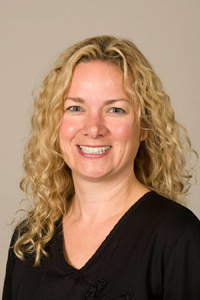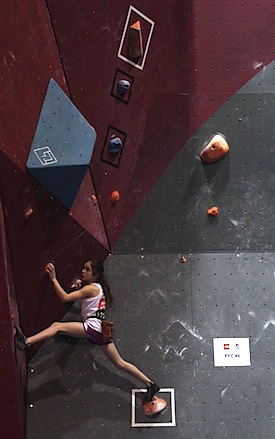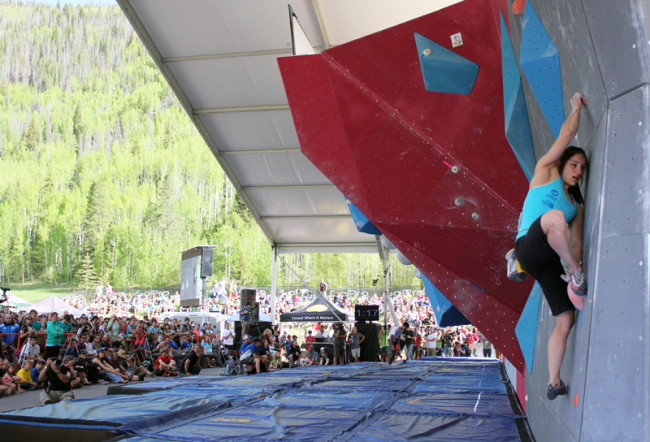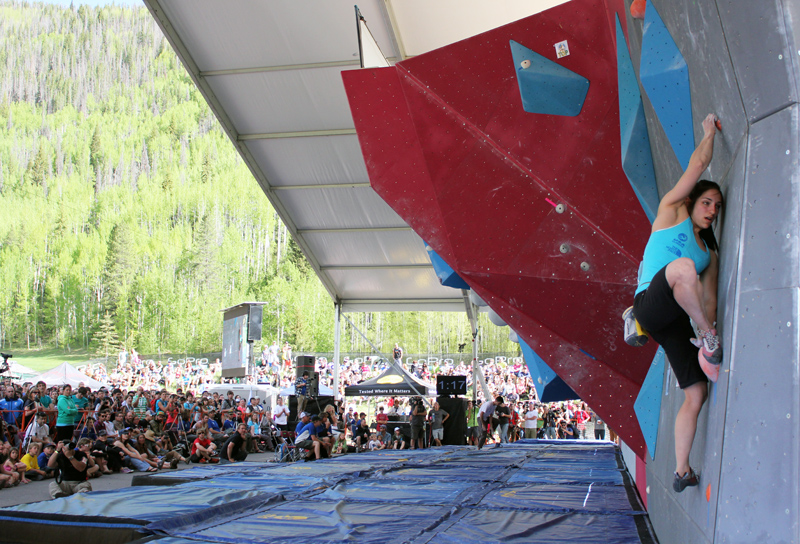
Earlier this year USA Climbing quietly made a change to how competitive climbing is run in America. That change came in the form of Mary-Clare Brennan, who was named CEO of the organization in April.
As the national governing body of competitive climbing in America, USAC organizes the Sport Climbing Series (SCS) and American Bouldering Series (ABS) competitions – whose National Championship events determine who is on the USA national climbing team – and the Collegiate Climbing Series (CCS). USAC is also responsible for hosting IFSC World Cup events in America. Brennan now leads the SCS Youth National Championships, which is one of the largest climbing comps in the world with over 460 competitors, two World Cup events, and nearly 200 local bouldering and roped competitions a year through the SCS, ABS and CCS series.
Even though USAC puts on some of the best competitions in the country, what Brennan cares most about is getting people to be members of USAC. “My focus is on building USA Climbing’s membership, not on events. The organization has done an outstanding job of building fantastic events. But we need to grow our membership and for the upcoming season, members will see a benefits program and other offers intended to increase the value that they receive as members of USA Climbing. That’s our primary objective right now,” said Brennan in an email interview.
Setting The Bar
Before Mary-Clare Brennan became USA Climbing’s Chief Executive Officer she worked for 18 years with the United States Olympic Committee’s Marketing Division. At the USOC she worked in securing new sponsorship revenue and leading sales efforts for the Team USA digital network.
“I started [with the USOC] in 1995, before the Atlanta Games, and advanced through the division, working in nearly every aspect of the business: Olympic brand management, National Governing Body marketing programs, sponsor service and eventually sponsorship sales. By the end, I had been selling U.S. Olympic and Paralympic Team marketing rights for a decade,” said Brennan.
Daron Pair, USAC’s Board President, said of hiring Brennan, “USAC is thrilled to have Mary-Clare as our new CEO. She brings a tremendous amount of experience from the United States Olympic Committee and her work with National Governing Bodies. Mary-Clare’s skill set aligns nicely with our goals for USAC and we are fortunate to have her on board.”
So what is Brennan’s vision for USAC? “Like any National Governing Body, USA Climbing is responsible for the entire pipeline of athlete development in the sport: from the grass roots, local level though the elite, international level. We need to continually grow the sport and develop world-class athletes who are competitive on a global level. However, in order to do that, we have to generate the revenue necessary to create the events, programs and opportunities required to develop athletes at all levels in the pipeline,” Brennan said.
An Uphill Climb
That is a tall order for an organization whose 2010 revenue was under $900,000. Brennan seems clear-eyed about this challenge and asserts that she is uniquely qualified to address USAC’s financial health. She said, “One of the benefits of not coming from the climbing community is that I can focus purely on the health and efficacy of the organization. My goal is simply to ensure that USA Climbing is a healthy, functional, transparent business that generates the revenue needed to achieve its objectives while managing expenses appropriately.”
Achieving this goals will not be easy. Before arriving at USAC Headquarters in Boulder, Colorado the entire national organization was being held together by two full-time staff members. Brennan said, “Kynan Waggoner, our Director of Operations, and Krista Dorsten, our Director of Membership and Marketing, deserve medals for running the organization for eight months without a CEO.” USAC’s former CEO, Keith Ferguson, stepped down in 2012 after leading the organization for four years.
Though the organization has very few full-time staff, Brennan gets help from a small army of unpaid volunteers that help the organization with a variety of tasks, from belaying and judging at competitions to serving as Regional Coordinators that spend countless hours organizing comps in their respective regions.
“With any small non-profit – especially one that is expected to have an impactful national reach – the major challenge is simply finding the resources to do all the things that need to be done and doing them well. So, while there are many projects that we’d like to tackle – and rebuilding our website is high on that list – we simply have to prioritize the immediate needs of the organization while still striving to achieve the strategic objectives that are going to push the organization forward to where we want it to be,” Brennan said.

Gym Hosts and Sponsors
One of the more immediate challenges that Brennan faces is convincing gyms to host one of those 200 local comps. USAC relies on commercial climbing gyms across the country to host sanctioned comps but its getting harder to find gyms that are willing to shut down their facility to host an event. Many gyms are doing the math and finding it doesn’t make sense to close their doors to members (from one to three days depending on the event) in order to host a competition that may have little immediate benefit to their members.
“We’re certainly aware of the challenges that gyms face in holding competitions, whether local, regional, divisional and national and we’re incredibly appreciative of the gyms that host those comps year after year. Of course, gyms do receive revenue for hosting competitions, whether it’s through local event registration fees or USA Climbing payments on a per athlete or flat fee basis,” Brennan said about a gym’s decision to host an event. “More importantly though, is for gyms to think about the intangible benefits of hosting comps: a home gym advantage for their teams; less travel, expense and stress for their athletes and parents; regional and national brand awareness for the gym and new member development through new competitive disciplines like paraclimbing.”
But perhaps the biggest challenge Brennan has to tackle is bringing in new sponsors that can support USAC’s mission of growing and enhancing the sport. Only a few large companies in the outdoor industry, such as The North Face, which is a long time sponsor of USAC, have provided significant financial support to USAC and its programs. Since taking on the role of CEO Brennan has signed one new sponsor, Kailas, a Chinese-based mountain apparel company.
One strategy USAC might approach is to bring in sponsors from outside the climbing industry, so-called non-endemic sponsors. The hope with this idea is to tap into a larger pool of money and thus have those resources to help USAC achieve its goals.
From her experience doing sponsorship sales at the USOC, Brennan said she does not believe there is any difference between “an endemic category sponsor’s dollar and a non-endemic one.” But she went on to say, “Our challenge is to ensure that USA Climbing can deliver a business return on a sponsor’s investment in a way that is both meaningful to the sponsor and authentic to the membership, regardless of what the category is.”
World Cups
One of USAC’s highest profile roles is the hosting of IFSC World Cups. World Cups are the pinnacle of competition climbing and garner a lot of media attention for the host country. Since 2009 the U.S. has hosted an IFSC Bouldering World Cup in Vail, Colorado in conjunction with the GoPro Mountain Games (formerly Teva Mountain Games). The Vail World Cup is a popular stop for European athletes on the World Cup circuit, and is often one of the only World Cups in which members of the USA climbing team can compete because of the high costs of traveling to comps in Europe and Asia.

In 2010 and 2011 the United States also hosted an IFSC Lead World Cup with two successful events at Movement Climbing + Fitness in Boulder, Colorado and Stone Summit in Atlanta, Georgia. The Lead World Cup series is the longest running international climbing competition series in the world, and is considered by many to be the standard bearer of competitive climbing.
After the Atlanta event, however, USAC was unable to secure funding to support a bid for the 2012 IFSC schedule. Asked if the Lead World Cup series would return to American soil Brennan said, “We’ll see. U.S.-based World Cups provide terrific high performance benefits for our elite athletes but they are also expensive to host. The IFSC has stringent requirements for the conduct of each World Cup as well as the way in which event branding and IFSC sponsor integration are managed. The decision whether or not to bid for, and host, a World Cup is necessarily a business decision as much as a competitive one.”
After this year’s Bouldering World Cup at the Mountain Games, many wondered if that comp would return to Vail. When asked about hosting the comp in 2014 Brennan was non-committal. “We have a great relationship with the Vail Valley Foundation, Vail is spectacular and the Go Pro Mountain Games are fabulous,” Brennan said. “It’s clear that athletes from around the world want to come to Colorado to compete in the Vail World Cup. Although we still have to weigh the high cost of hosting the event and other business considerations, I’d like to see the event stay in Vail during the Mountain Games, in one form or another.”
The Road Ahead
With all these challenges Brennan has hit the road running and has achieved a lot in her fist six months on the job. “I’m proud to say that we’ve implemented an overhaul of the organization’s insurance program, signed a new major sponsor, held the largest U.S. paraclimbing competition in history and hosted a highly successful U.S. Youth National Team Training Camp, followed by a terrific U.S. Team performance at the World Youth Championships in British Columbia,” Brennan said of her accomplishments thus far.
Yet over the next few years Brennan needs to continue growing USAC’s member and sponsorship base in order to achieve her goals of enhancing the sport and its athletes. By proving USAC’s value to members, gyms and sponsors she can lead USAC down a path of greater financial security, which should improve the experience of competitive climbers in the U.S. and bring more certainty about the future of World Cups in America.
Mary-Clare Brennan is bullish on the organization’s future. “I think that the current team running USA Climbing – from the Board to the staff – are in alignment to take the organization to a new level over the next few years.”

Climbing Business Journal is an independent news outlet dedicated to covering the indoor climbing industry. Here you will find the latest coverage of climbing industry news, gym developments, industry best practices, risk management, climbing competitions, youth coaching and routesetting. Have an article idea? CBJ loves to hear from readers like you!






